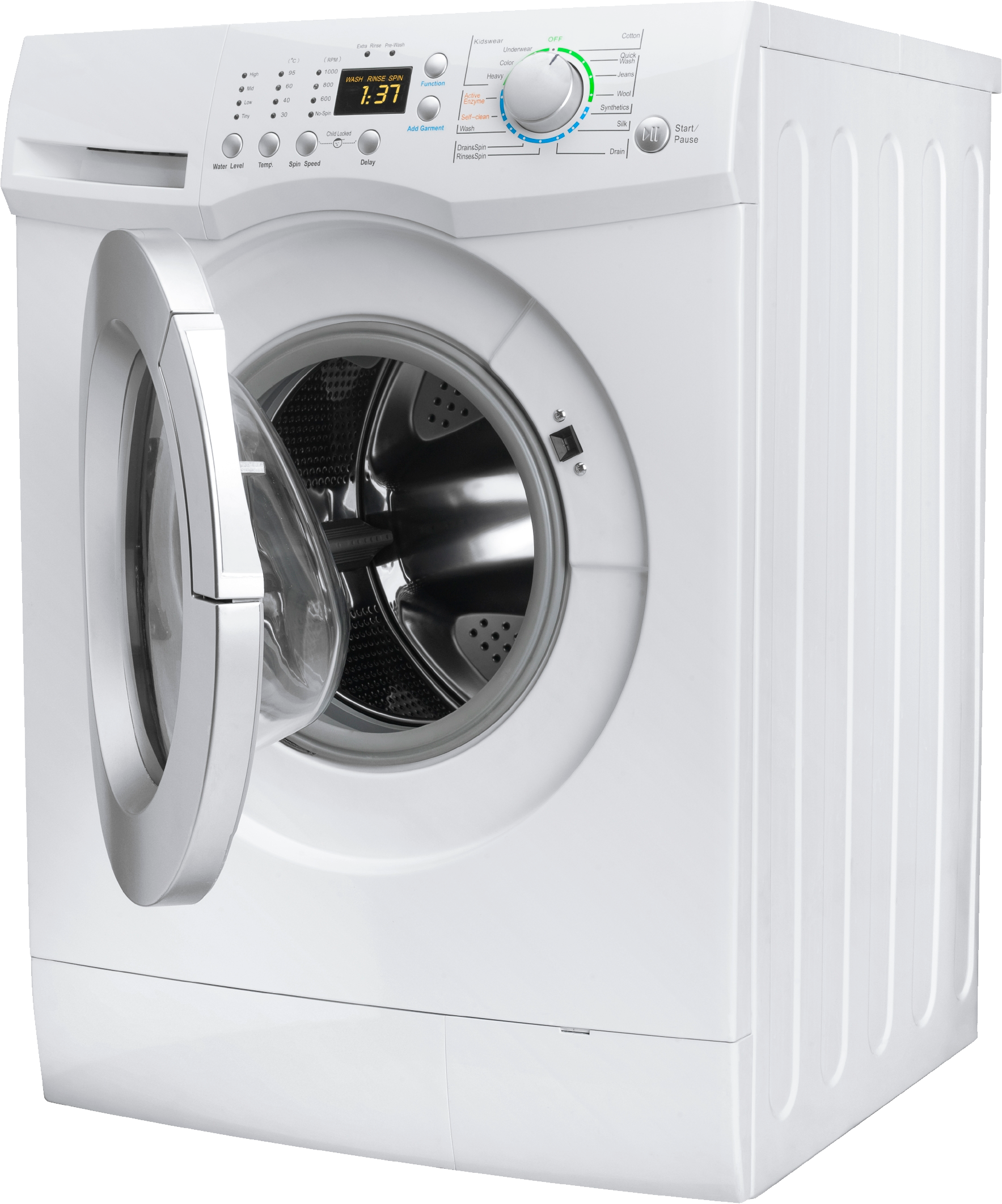
This image has format transparent PNG with resolution 1767x2124.
You can download this image in best resolution from this page and use it for design and web design.
Washing machine PNG with transparent background you can download for free, just click on download button.
A washing machine (laundry machine, clothes washer, or washer) is a home appliance used to wash laundry. The term is mostly applied to machines that use water as opposed to dry cleaning (which uses alternative cleaning fluids and is performed by specialist businesses) or ultrasonic cleaners. The user adds laundry detergent, which is sold in liquid or powder form, to the wash water.
Over time manufacturers of automatic washers have gone to great lengths to reduce cost. For instance, expensive gearboxes are no longer required, since motor speed can be controlled electronically. Some models can be controlled via WiFi, and have angled drums to facilitate loading.
Even on some expensive washers, the outer drum of front loading machines is often (but not always) made of plastic (it can also be made out of metal but this is expensive). This makes changing the main bearings difficult, as the plastic drum usually cannot be separated into two halves to enable the inner drum to be removed to gain access to the bearing.
Some manufacturers have taken steps to reduce vibration emanating from their washers, by means of reducing or controlling motor speeds, using hydraulic suspensions instead of spring suspensions, and having freely moving steel balls (Samsung VRT) or liquid contained inside a ring mounted on both the front and back sides of the drum in order to counter the weight of the clothes and reduce vibration.
Some machines, since 1998 now use a direct drive motor, a low aspect ratio device, where the stator assembly is attached to the rear of the outer drum, whilst the co-axial rotor is mounted on the shaft of the inner drum. Direct drive eliminates the need for a pulley, belt and belt tensioner. It was invented by LG Electronics in 1998 and patents were granted in the US in 2010. Since, other manufacturers have followed suit. Some washing machines with this type of motor now come with 10-year warranties. The direct drive motor's rotor is outside the stator as this provides a slim motor with speed reduction and torque multiplication. The rotor is connected to the inner tub through its center. It can be made out of metal or plastic.
Today, faster load speeds are becoming a higher and higher demand. Some US companies are working on developing new spin technology to wash clothes faster and more efficiently. Lightning Clean is one of these companies. They are producing the first 10-minute washing machine.
The front-loading or horizontal-axis clothes washer is the dominant design in Europe. In other regions of the world, most "high-end" washing machines are of this type. In addition, most commercial and industrial clothes washers around the world are of the horizontal-axis design.
This layout mounts the inner basket and outer tub horizontally, and loading is through a door at the front of the machine. The door often but not always contains a transparent window. Agitation is supplied by the back-and-forth rotation of the cylinder and by gravity. The clothes are lifted up by paddles on the inside wall of the drum and then dropped. This motion flexes the weave of the fabric and forces water and detergent solution through the clothes load. Because the wash action does not require the clothing be freely suspended in water, only enough water is needed to moisten the fabric. Because less water is required, front-loaders typically use less soap, and the repeated dropping and folding action of the tumbling can easily produce large amounts of foam or suds.
Front-loaders control water usage through the surface tension of water, and the capillary wicking action this creates in the fabric weave. A front-loader washer always fills to the same low water level, but a large pile of dry clothing standing in water will soak up the moisture, causing the water level to drop. The washer then refills to maintain the original water level. Because it takes time for this water absorption to occur with a motionless pile of fabric, nearly all front-loaders begin the washing process by slowly tumbling the clothing under the stream of water entering and filling the drum, to rapidly saturate the clothes with water.
Front-loading washers are mechanically simple compared to top-loaders, with the main motor (a universal motor or variable-frequency drive motor) normally being connected to the drum via a grooved pulley belt and large pulley wheel, without the need for a gearbox, clutch or crank. Some models, such as those by LG, utilitize a motor directly connected to the drum, eliminating the need for a belt and pulley. But front-load washers suffer from their own technical problems, due to the drum lying sideways. For example, a top loading washer keeps water inside the tub merely through the force of gravity pulling down on the water, while a front-loader must tightly seal the door shut with a gasket to prevent water dripping onto the floor during the wash cycle. This access door is locked shut with an interlocking device during the entire wash cycle, since opening the door with the machine in use could result in water gushing out onto the floor. In most machines, the interlock is usually doubly redundant to prevent either opening with the drum full of water or being opened during the spin cycle. For front-loaders without viewing windows on the door, it is possible to accidentally pinch fabric between the door and the drum, resulting in tearing and damage to the pinched clothing during tumbling and spinning.
In this page you can download free PNG images: Washing machine PNG images